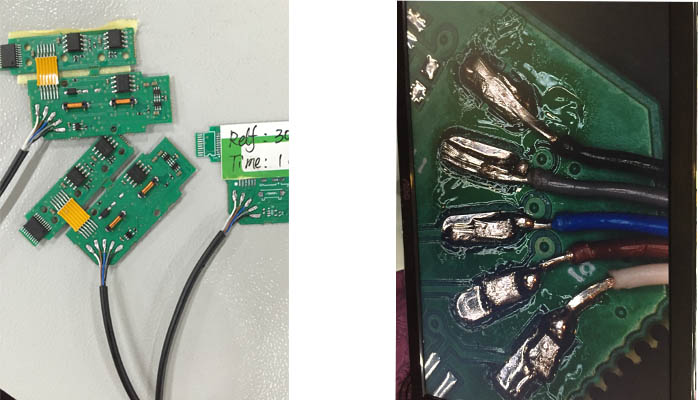How hotbar works
Hotbar is also known as "pulse hot press welding", but most people in the industry literally call it "hotbar". The principle of hotbar is to first print the solder paste on the solder pad of the circuit board (PCB), then melt the solder paste in the reflow oven and pre solder it on the circuit board, and then place the solder to be soldered (generally FPC) on the printed circuit board, Then use the heat of the hot indenter to melt the solder and connect the two electronic components that need to be connected.

It is called hotbar because the flat object to be soldered (usually FPC) is soldered on the circuit board by using long strip hot indenter. I think its name is to distinguish the heatseal process that also uses hot indenter to paste ACF on LCD or circuit board.
Hotbar usually solder FPC to PCB (as shown in the figure above), which can achieve the purpose of light, thin, short and small. In addition, it can effectively reduce the cost, because 1-2 FPC connectors can be used less.
The principle of general hotbar hot press is to heat the modes / heater tip by using the huge Joule heat generated by [pulse] flowing through molybdenum, titanium and other materials with high resistance characteristics, and then melt the solder paste on PCB by using the hot head to achieve the purpose of mutual welding.
Since pulse is used for heating, the energy and time control of pulse is very important. The control method is to use the thermocouple circuit at the front end of the hot indenter to feed back the temperature of the hot indenter to the power control center, so as to control the pulse signal to ensure the correctness of the temperature on the hot indenter.
Process control of hotbar
▪ Control the gap between the hot indenter and the object to be pressed (usually PCB). When the hot indenter drops to the object to be pressed, it must be completely parallel to the object to be pressed, so that the object to be pressed will be heated evenly. The general method is to loosen the screws which are locked on the hot press by the hot head first, and then adjust them into manual mode. When the hot head is lowered and pressed on the pressing material, confirm that after full contact, screw the screws tightly, and finally raise the hot pressing head. Usually, the object to be pressed is PCB, so the hot indenter should be pressed on the PCB. It's better to find a plate without tin to adjust the machine.
▪ Control the fixed position of the object to be pressed. Generally, the objects to be pressed are PCB and soft board. It is necessary to confirm that the PCB and soft board can be fixed on the fixture platform. At the same time, it is necessary to confirm that the position of hotbar is fixed each time, especially in the front and back direction. When there is no fixed object to be pressed, it is easy to cause empty welding or crush the quality problems of nearby parts. In order to achieve the purpose of fixing the object to be pressed, the design of
For PCB and FPC, special attention should be paid to the design of additional positioning holes. The best position is near the hot pressing of molten tin, so as to avoid the displacement of FPCB during pressing.
▪ Control the pressure of hot press. Please refer to the suggestions provided by the hot press manufacturer.
▪ Is it necessary to add flux? Flux can be added as appropriate to facilitate the smooth welding. Of course, it's best to achieve the goal without adding. Because the solder paste is printed on the circuit board and flows through the reflow oven, the flux in the original solder paste has been evaporated, so when pressing hotbar, it is usually necessary to add flux once to improve its soldering ability. The purpose of flux is to remove oxide
